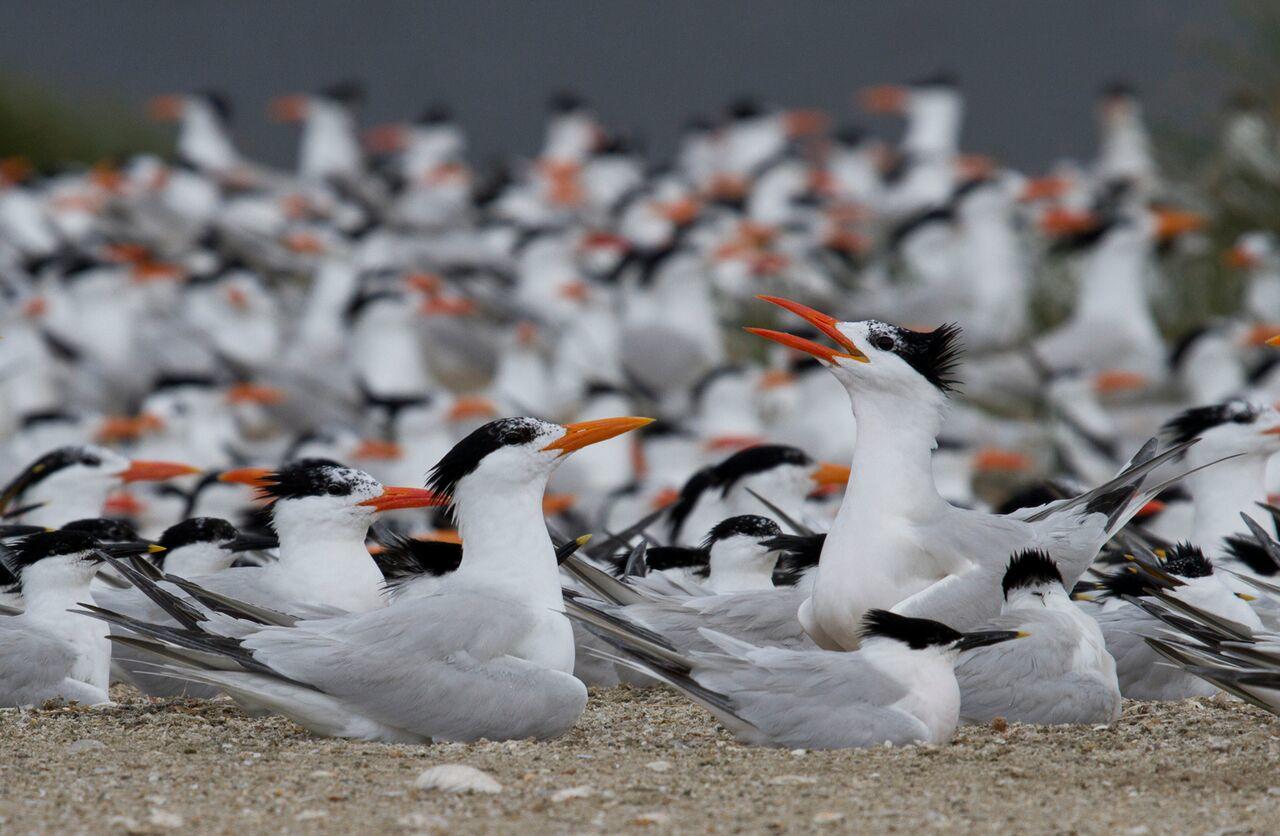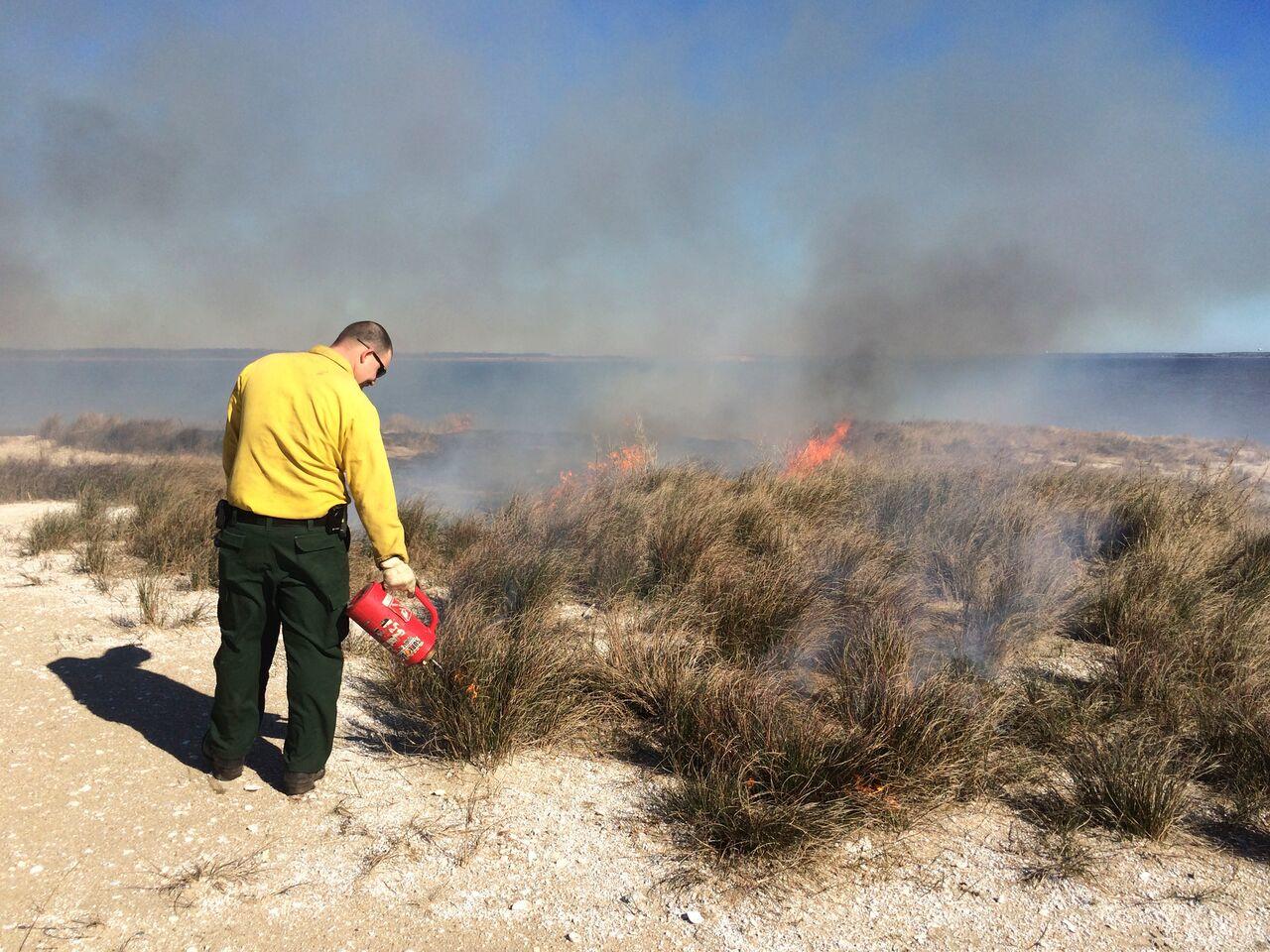Below the Port of Wilmington, the Cape Fear River widens as it nears the Atlantic Ocean. This stretch of river is dotted with islands, some low and marshy, some sandy and hill-like and others covered with mature trees. What most of them have in common is that they were created by people. As the river was dredged deeper to create a channel that could accommodate commercial ships, the sand and mud that was removed accumulated at spoil sites became islands.
Two of these dredged-material islands are of importance for a wholly unintended and unexpected reason. Though they were originally just a convenient place to put dredged-up sand during a 1970s-era project, soon after their creation Ferry Slip Island and South Pelican Island became indispensable to nesting birds, including Royal Terns and Sandwich Terns. In fact, South Pelican was originally called Old Royal Tern Island because it attracted so many of them. When later it was discovered by Brown Pelicans, it got a new name.
Though the story of the naming of islands is amusing, it underscores their importance to species that nest in coastal North Carolina. Royal and Sandwich Terns nest in large, dense groups called colonies. They look for open, sandy habitat that is free of vegetation and hopefully far removed from mammalian predators like raccoons. Without realizing it, when making dredged-material islands, people were making tern habitat. The islands are made of coarse sand that drains well when it rains so eggs don’t bog down in puddles, support any mammals that would eat eggs or chicks, and with their large dome shape, are safely above storm tides. The past ten years of statewide survey data collected by Audubon North Carolina staff who manage the islands found as many as 36% of Sandwich Terns (946 pairs) and 24% of Royal Terns (2,692 pairs) nesting on the islands in the Lower Cape Fear River. Statewide, they only occupy a handful of sites, from a high of nine in 2007 to a low of five in 2014. Thus, Ferry Slip Island and South Pelican Island amount to a great deal of the habitat in North Carolina that is suitable for these terns. Loss of low natural islands in Pamlico Sound and human disturbance on barrier island beaches make dredged-material islands the last best places for them to nest.

Other species benefit from Ferry Slip and South Pelican Islands as well. In particular, Gull-billed Terns, a state threatened species, make use of these sites along with a growing number of American Oystercatchers. Like the Royal and Sandwich Terns, they tend to prefer open areas without much vegetation, though they will also use shell banks that fringe marsh islands as well as sandy sites like dredged-material islands and barrier island beaches.
In modern times, the U.S. Army Corps of Engineers has been responsible for maintaining navigational channels and, as a beneficial by-product, creating and maintaining dredged-material islands. Projects that recurred periodically over the years brought new sand, which buried encroaching vegetation that would crowd out nesting terns and shored up the islands when they eroded. Project managers from the Corps worked with biologists from Audubon North Carolina and the NC Wildlife Resources Commission to place the sand most advantageously, so the slope and shape of the islands were most suitable for nesting birds. However, between 2005 and 2015, no dredge projects were funded near Ferry Slip or South Pelican Island and the islands began to become too vegetated with grasses and herbaceous shrubs. A dredging project commenced in 2016, but the sand wasn’t placed on the islands because a permit could not be obtained in time. Without dredged sand to maintain the right sandy habitat for the terns, the islands could eventually become useless to the birds.
Despite the absence of fresh sand, Audubon North Carolina received funding from the Duke Rivers and Waters Program, which is administered by the National Fish and Wildlife Foundation to manage habitat on the islands through other means. Starting this year, the project funds three years of vegetation management on the islands to burn them after nesting concludes, mechanically till the most vegetated island and treat both islands with herbicide. Audubon North Carolina is coordinating with the NC Forest Service and the NC Wildlife Resources Commission’s habitat management division to implement the work. The process is modeled on a similar project in coastal Georgia where a newly created dredged-material island has been successfully maintained by the Georgia Department of Natural Resources and the U.S. Army Corps of Engineers.

Because the islands are occupied by their avian tenants during the spring and summer, work began this winter. Recently, we coordinated with the NC Forest Service and burned both islands successfully removing most of the unwanted vegetation on South Pelican, but leaving a marshy area intact for use by herons, egrets and Brown Pelicans. Much green vegetation remains on Ferry Slip due in part to the mild winter, so next the entire island—a little less than five acres—will be tilled and graded back to a smooth surface. This will expose bare sand again, but since there is a healthy bank of seeds waiting to sprout when the weather warms, the final step we’ll take this winter is to apply herbicide on both islands that will prevent or slow new vegetation coming in during the growing season. Anyone who’s ever tried to remove a lawn in order to revert back to a natural yard or discourage unwanted weeds knows that controlling vegetation takes time, which is why the burning and herbicide treatments will continue for two more years. As the islands await the next deposit of sand from the Corps, we can make sure they will continue to support thousands of pairs of birds every spring.



